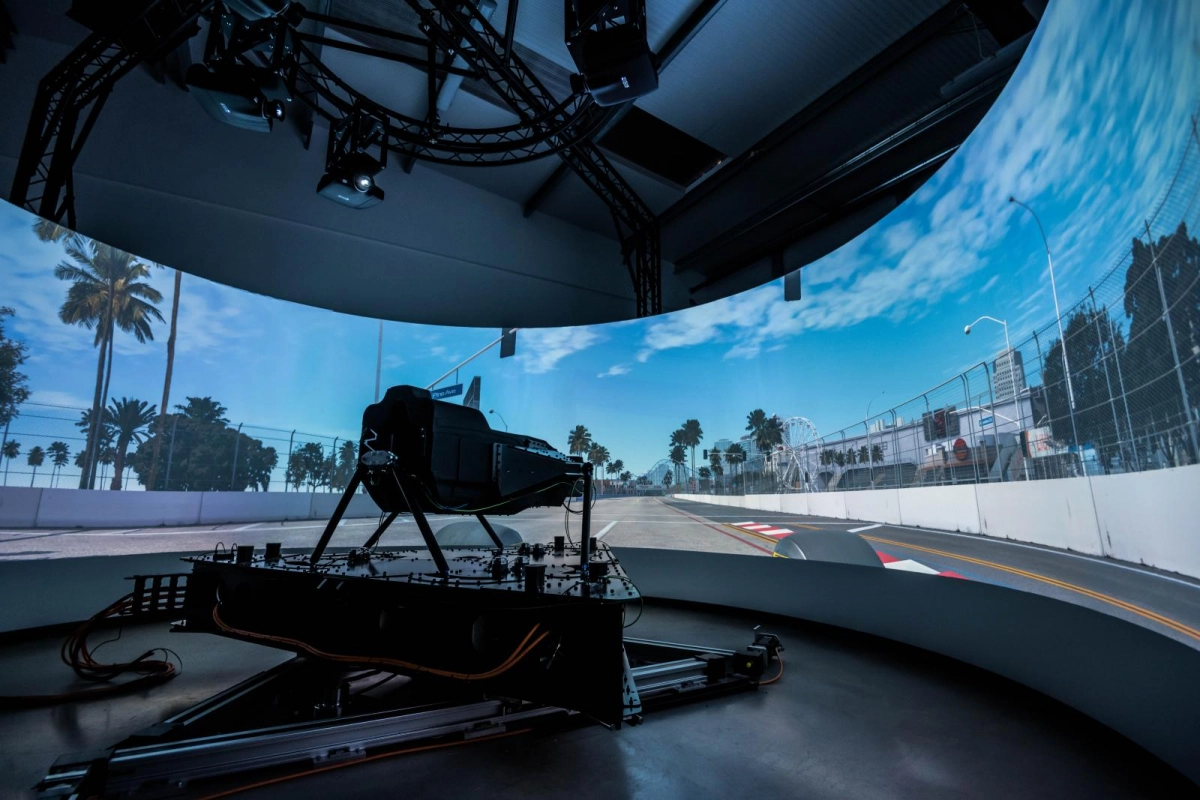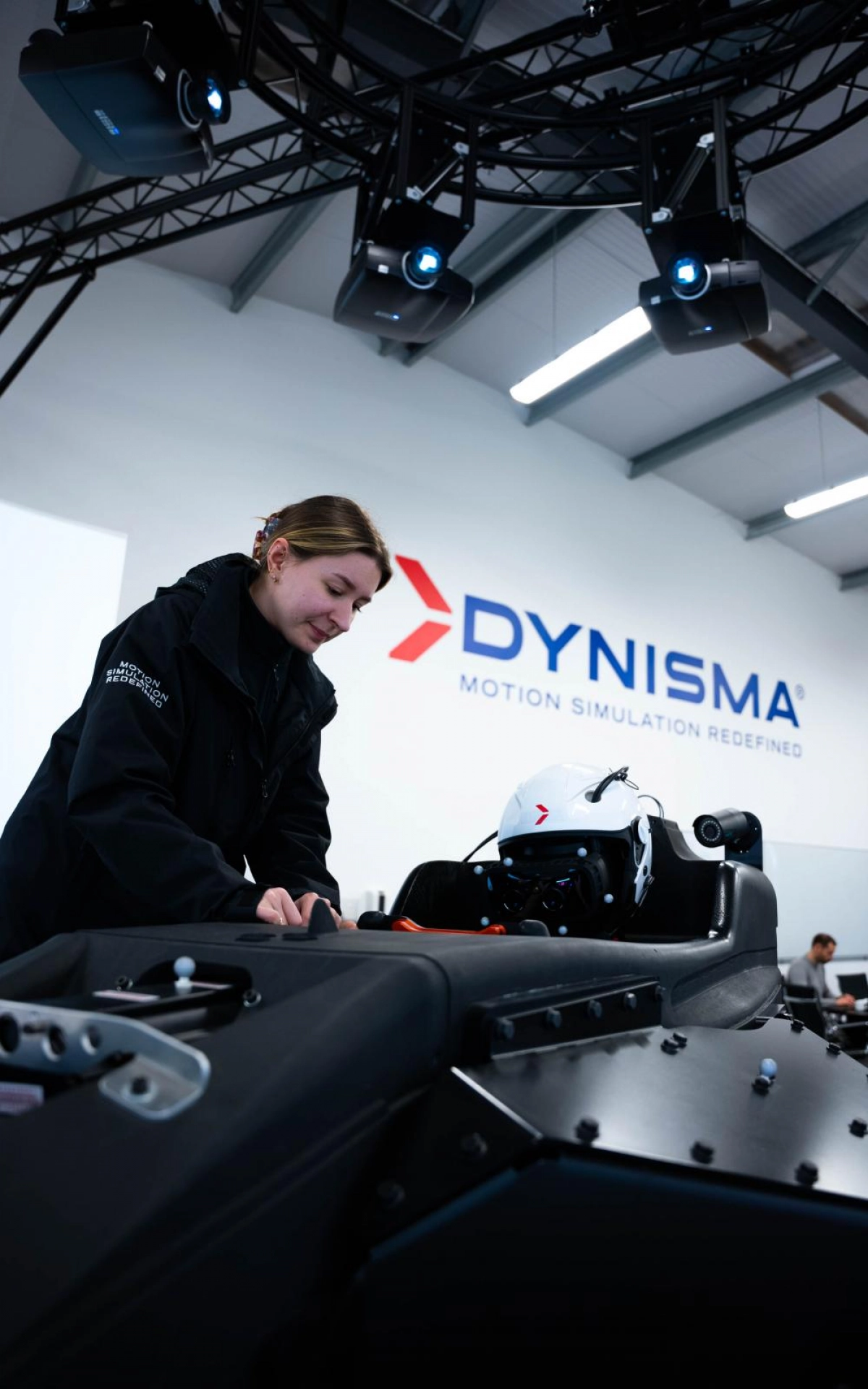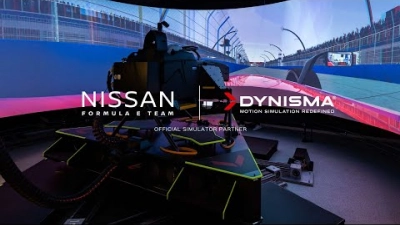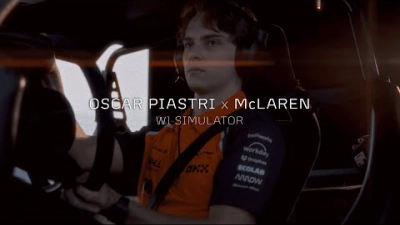When a simulator is as advanced as our solutions, you need visualisation technology to match, otherwise some of the benefits the driver is feeling could be lost on screen. At Dynisma, we work with ST Engineering Antycip who are leaders in their field and whose commercial manager, John Mould, has provided insight into the visualisation solutions available to customers and the latest developments in the technology.
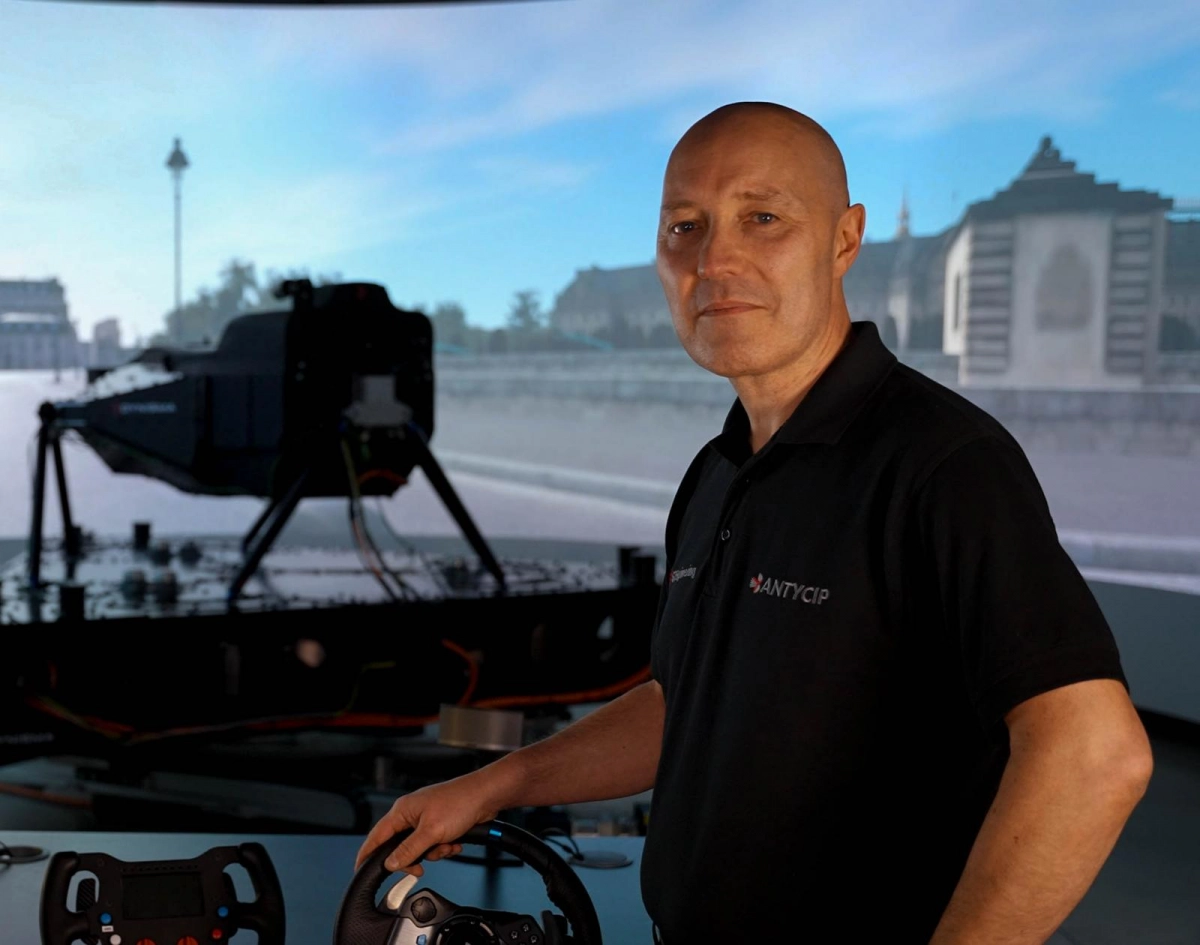
How many different visualisation options do driving simulator users have when choosing a turnkey solution?
There are a wide range of off the shelf display solutions to immerse the driver within a simulator, these options take into account the price, performance levels and customer requirements to generate the right technology configuration. These solutions include projection-based systems, facetted flat panel displays and even head mounted displays.
Dynisma focuses on the mid and high-end professional grade solutions, starting with custom tailored multi-channel projection arrays and cylindrical screens designed to meet specific field of view parameters, as defined from the driver’s eyepoint. Our capabilities extend to providing the latest in solid-state LED and laser-based projection hardware that meet professional level simulation requirements.
Our portfolio embraces a multitude of different screen substrates, including solid GRP for those clients seeking the best continuous image quality. Clients can choose resolutions which can boast a native pixel count of 4K per channel with frames rates up to 240Hz.
Beyond the projected display technologies, we also provide the next generation of visual display systems in the form of Direct View LED arrays that operate with attributes specifically designed for simulation purposes.
What should driving simulator customers know / what should they consider when looking for the right visualisation solution for them?
There are many factors which should be considered when selecting the right visual solution for your requirements.
One crucial point is the requirements of the image itself - the contrast, luminance, and optical properties – in addition to how the image will be generated and what pixel resolution is necessary.
It is also important to think about what other features are required such as smear reduction, digital correction, and depth perception, and how these need to be implemented.
The rendering performance, latency of the video signal and target frame rate are all factors which must be taken into account when specifying what type of image processing will support the necessary electronics bandwidth. The type of optics to be used, their depth of focus and their configuration to minimise shadowing of the light paths should also be considered.
Another key consideration is the field of view at the drivers eyepoint, taking into account the motion envelope of the simulator in action.
Customers also shouldn’t forget about requirements outside of the actual technology itself. For example, the access requirements for both the driver and for maintenance, mechanical structures required to mount the display hardware and any building restrictions for where the simulator will be integrated.
These are just some of the considerations that we can provide guidance on to ensure the visual solution can address the final operational needs of our clients.
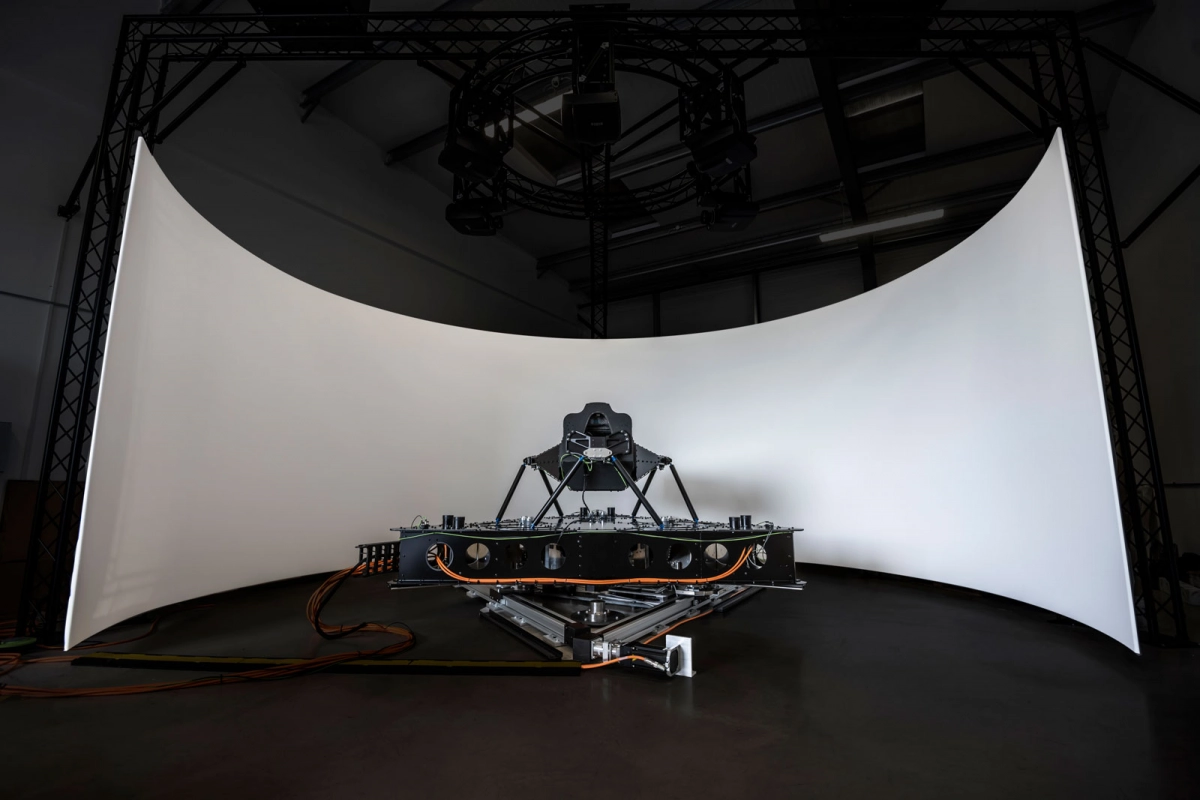
Can you explain what the latest is in projection / light engine technology?
Today the light engines within modern projection hardware have evolved and we are saying goodbye to the challenges presented by lamp-based projectors with their requirements for replacement consumables.
As we transition away from these types of projectors, we have embraced laser phosphor and RGB laser light sources that not only increase the lumens budget for our displays but also result in superior colour reproduction levels than before. This also allows longevity for the delivered images -from 20,000 operational hours and beyond depending on the final model and its power settings.
LED based light sources have further increased this longevity expectation from 50,000 to 100,000 operational hours, reducing the moving components within the projector chassis so that minimal replacement parts should be required over this period. LED projectors offer a wide colour gamut, with colour reproduction levels beyond their laser counterparts. These new light sources enable multi-channel arrays with an increased stability for the uniformity of the images over time thanks to features such as constant light output to help balance the operational characteristics of each unit.
The latest in digital projection technology gives the freedom to orientate and mount the projectors while not having to consider the adverse effects such positions would impose on a previous lamp-based chassis. Modern light sources open up new possibilities including emerging technologies that even divorce the light source from the projector’s chassis itself so that it can be managed within the equipment racks.
What are the benefits of LED walls vs projectors?
Projection technology is very traditional and highly advanced for driver-in-the-loop simulation displays, however direct view LED technology has entered the simulation realm to address many of its known challenges.
Direct View LED Tiles are mounted upon a mechanical structure around the simulator, displaying the visual content directly to the driver’s eyes. This is different to projection whereby the light path is generated within the projector chassis and directed through the optics to be mapped, then reflected upon a screen substrate. The direct view displays have a number of benefits:
- The image contrast and brightness are not reliant on the optical properties of a screen surface to ensure optimum results
- As there is only the directly emitted light from the display to consider, the operation of the motion platform does not create any shadowing that would need to be compensated for in the design process
- There is no over projection and no loss of pixels, so a brightness level can be delivered that can far exceed that of a typical projection system. This requires less control over the room lighting conditions and enables the delivery of images that appear to replicate daylight in the synthetic environment more realistically
- Replication of driving at night is much simpler than with traditional projection technology, which required a number of solutions to avoid the degradation of the image caused by overlapping of the projector channels
- Maintenance is reduced as the longevity of the technology is much greater and, should an LED tile need to be replaced, this can be easily accessed from the front reducing the manpower required
- Operational noise is negligible compared to projectors, which require fans to cool them
- There is no requirement to digitally correct the direct view LED display surface as the tiles are mechanically aligned to form a cylindrical image around the simulator, it is only the synthetic content that needs to be corrected
What is the most cost-effective vs most expensive solution?
The most cost-effective solutions for display are consumer grade head mounted displays which can be purchased with their tracking accessories for less than £1000. Of course, you get what you pay for, and there are many limitations at this level.
The high-end direct view LED technologies require a lot of engineering to set up, depending on the configuration, and can easily cost more than £1 million depending on the scale and complexity of the final solution.
How has projection technology evolved over the last few years? Any key innovations?
Projectors today have moved away from the constraints imposed by having high pressure lamps that require replacement after around 1,500 operational hours. The solid-state solutions available today extend the life cycle of the core light source beyond 50,000 hours with reduced engineering required and producing more stable and uniform images.
Projectors can operate with 4K native pixels at 240Hz frame rates courtesy of the latest generation of digital imaging devices. Pixel shifting technologies allow oscillation of the pixels with one step actuation functionality to offer perceived pixel counts over 6K on screen per channel and higher. Digital correction can be applied directly by some projectors offering high bandwidth electronics to retain the native pixel count which was not possible in the past without compromise.
Motion worthiness of simulation grade projectors has increased with units tested beyond 3G and up to 15G in some models, allowing the display to be carried directly upon the most intense of motion systems. Stereoscopic depth perception has also seen innovations such as high-resolution multiview 3D capabilities, allowing a driver and up to 2 additional passengers to have their own dynamic eye point spatially tracked and presented simultaneously at a native 4K-120Hz per user.
The brightness levels of projectors have also risen with the introduction of the laser light sources. Over 25,000 lumens are now possible from a chassis yet such units can still be powered from a standard mains outlet as opposed to the previous three phase and high amperage power requirements. It is even possible to remove the light source of a projector from its chassis and manage these laser modules within an equipment rack.
In summary, projection technology has continued to push the boundaries of what is possible and working with the leading manufacturers we can design innovative configurations to meet new challenges.
How advanced is VR / XR paired with a driving simulator?
VR headsets have dramatically moved forward over the last few years. Some key manufacturers have increased the field of view and the pixel resolution to offer a very immersive experience. The introduction of low latency cameras in such headsets has enabled mixed reality applications to be realised. This combines the synthetic out of the window view with the driver’s own hands on the wheel within their primary view. This type of technology means it is now even possible to drive a real vehicle while simulating the interior options and next generation heads up displays...

